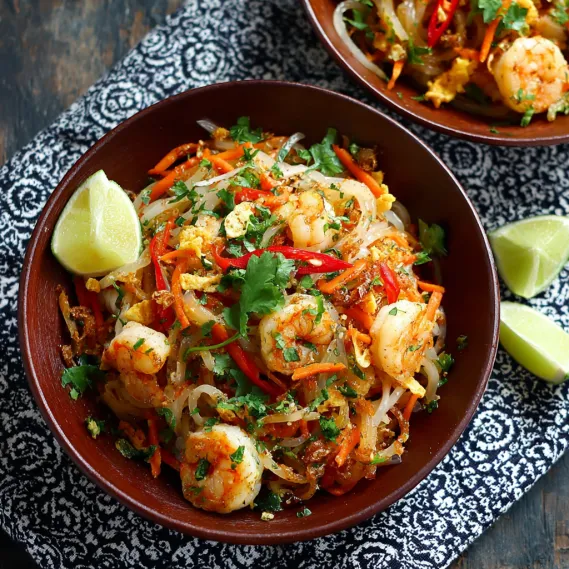 Pin
Pin
This robust Paleo Shrimp Pad Thai turns a popular Thai favorite into a gluten-free, low-carb treat by using spiralized carrots instead of regular rice noodles. The mix of juicy shrimp, crisp veggies, and genuine Thai tastes makes a guilt-free version that keeps all the charm of the original dish.
I found this dish during my month-long paleo challenge and it quickly became our go-to "better takeout" option at home. Even my husband, who loves his carbs, now asks for this version more than the traditional pad Thai!
Ingredients
- Raw peeled and deveined shrimp: try to get wild caught for better taste and eco-friendly eating
- Green Giant Veggie Spirals Carrot: or make your own fresh carrot spirals as the noodle base
- Almonds: they give that needed crunch that peanuts normally add in regular pad Thai
- Fish sauce: this gives the key savory kick that makes Thai food taste real
- Lime juice: brings freshness and cuts through the rich flavors
- Honey: adds just enough sweetness to balance the tangy sauce
- Coconut aminos: brings saltiness with less sodium than you'd get from soy sauce
- Birds eye chili pepper: gives that real Thai kick - use more or less based on how spicy you like it
Simple Cooking Guide
- Brown the Almonds:
- Toss almonds into a dry pan on medium-low and cook for 4 to 5 minutes until they turn golden and smell nutty. Keep stirring so they don't burn - they can go from just right to ruined pretty fast. This step really boosts flavor and adds that satisfying crunch pad Thai needs.
- Fix the Protein:
- Warm coconut oil in a big pan over medium-high until it shines. Throw in shrimp and onions together and cook for exactly 3 minutes until shrimp go pink and onions start to look clear. Don't cook the shrimp too long or they'll get tough. Take them out and set them aside.
- Ready the Noodles:
- Put the rest of your coconut oil in the same pan and add carrot spirals. Cover and let them cook for 8 minutes, stirring now and then. The steam under the lid helps make the carrots just soft enough to feel like real noodles.
- Cook the Eggs:
- Make a hole in the middle of your carrots and pour in your beaten eggs with green onions. Stir the eggs until they're almost done, about 1 minute. They'll finish cooking from the heat that's already in the pan and stay nice and soft.
- Mix and Serve:
- Put the shrimp and onions back in and add bean sprouts plus your pad Thai sauce. Mix everything for just 30 seconds so flavors blend without overcooking. Take it off the heat right away to keep everything at the perfect texture.

The key thing that really makes this dish pop is the fish sauce. I once tried making it without fish sauce to make it more kid-friendly. What a difference! Fish sauce gives that special savory taste that makes you crave Thai food. Now my kids agree - no skipping the fish sauce!
Prep Ahead Options
This paleo pad Thai stays good in your fridge for up to three days if you keep it in a sealed container. I've noticed the flavors actually get better overnight, sometimes making day-old leftovers tastier than when it's first made. When you want to warm it up, just put it in a pan with a tiny bit of water so it doesn't dry out. I wouldn't freeze this one though - both the carrots and shrimp get weird when thawed.
Easy Swaps
You can easily change this recipe based on what you've got at home. Small pieces of chicken thighs work great instead of shrimp, just cook them for 5 to 6 minutes rather than 3. Want to skip meat? Use pressed firm tofu cut into cubes and swap the fish sauce for more coconut aminos. Can't find carrot spirals? Zucchini noodles work too, but they only need 2 to 3 minutes of cooking or they'll turn mushy.
What to Serve With It
This paleo pad Thai tastes amazing by itself but gets even better with a few extras. Put out lime wedges so everyone can squeeze some juice on their portion for extra zing. A side of fresh cucumber salad makes a cool contrast to the rich main dish. For folks who want more heat, put out some red pepper flakes or sriracha. I like to bring the whole thing to the table on a big plate with lots of cilantro and extra bean sprouts on top - it looks great that way.
The Story Behind It
Regular pad Thai got popular in Thailand during World War II when the government pushed rice noodles to save rice supplies. This paleo version keeps all the great flavors while fitting modern diets. It still has that perfect mix of sweet, sour, salty and spicy even without the usual rice noodles and peanuts. It shows how we can update classic foods while still respecting where they came from.
Common Questions About This Recipe
- → What makes this dish Paleo-friendly?
Instead of regular noodles, we use carrot spirals and stick to natural stuff like shrimp, coconut oil, and honey that fit Paleo eating patterns.
- → Can I make this dish spicier?
Sure thing. Just throw in more bird's eye chilies or a sprinkle of chili flakes to bump up the heat to whatever level you want.
- → Can I use fresh carrots instead of packaged spirals?
Absolutely. You can make your own carrot spirals at home. Just remember they'll cook faster than store-bought ones, so only cook them for about 2 minutes.
- → Are there substitutes for mung bean sprouts?
You can swap mung bean sprouts for zucchini noodles, thin cabbage strips, or just leave them out completely.
- → Can I make this dish Whole30 compliant?
You bet. Just don't use the honey in the sauce and double-check that all your other ingredients work with Whole30 rules.
- → How do I store leftovers?
Put any extras in a container with a tight lid and keep in your fridge for up to 3 days. Make sure to heat it all the way through before you eat it again.
